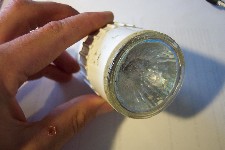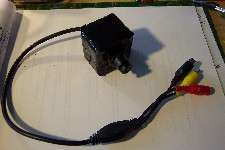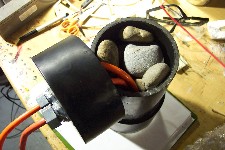


PHOTON DETECTION AND IMAGING SYSTEM
Gillian brought home a pile of color CCD cameras with power supplies from her work. Apparently they were all purchased
for a security system that was never installed. So instead of a boring trip to the dump, these cameras will face
the ultimate peril as they are subjected to most certainly horrible and torturous destruction under my command. With these
cameras, I could send an image signal to the surface of the bay to display and record.

SUPPLEMENTAL PHOTON GENERATION SYSTEM
Guess what itís like under 30 feet of silty gross contaminated san francisco bay water? Dark, real dark. So dark that a
light might be a real good idea
if you wanted to see anything but the dark. The light I used for this project was my old bike light that I made from
a 12V 20W flood lamp mounted in some PVC fittings. You like that hole I drilled in my thumb?


HIGH PRESSURE WATER RESISTANCE ENGINEERING
Ok, so what else is it like under 30 feet of water? It's pretty darn wet too. I didn't try it but I would suspect that my CCD cameras would probably not work very well submerged in stinky brine for long. So the majority of the work on this project involves the water-proofing of the camera and light. The first thing I did was wrap the camera circuit board in black duct tape. Now by itself, duct tape probably isn't the best water-proofing solution but it is another layer in preventing water from getting in there. I would have encapsulated the entire circuit board with a silicone molding compound but i haven't got any. So after the duct tape, I decided to jam the camera and the light inside some PVC pipe (actually ABS pipe). I figured that since that plastic pipe was so often used to keep water inside it, the same pipe would probably work well to keep water out of it. So after a trip to Orchard Hardware and Supply, I started work on the camera casing. I began by cutting out a 'window' of plexiglas with a hack-saw. After it was roughed out with the saw, I PVC cemented it to a 4" ABS coupling and let it set. When cured, I sanded the window down and round so that it sat flush with the outside of the 4" coupling using a dremmel tool. After the window was done, I jammed the camera and light up against the window as best I could. Then i packed the open space (around the camera and the light) with bubble wrap, trying not to cover up the camera lens. At first i tried packing peanuts but they just busted up and made a mess. Then I glued in a section of 4" ABS pipe, maybe 6" long. On the non-business end of the shark-cam, I drilled two 3/4" holes in the ABS cap and screwed in two 1/2" NPT cord-grip electrical connectors. These guys would allow me to seal around the cables for the power and video signal. Everything would be double-triple glued with RTV sealant and PVC glue and I would pray that it would be water tight enough.

ULTRA-HIGH TECH DEEP-SEA COMMUNICATION CABLES
For deep-sea cables, I bought a 50 ft orange extension cable at the
hardware store; this was used for the 12V power for the camera and the light. I had another 50 ft'er at home and used
it for the video signal. It would have been better to use a shielded cable like an RCA, but I didn't have a 50 ft RCA
cable laying around in the garage.

HIGH PERFORMANCE ORGANIC BALLAST
Ok, if there is one feature on a submersible camera you would like to avoid it has got be be buoyancy. You don't want
a camera that floats like a fishing bobber unless you are interested in filming swans or ducks. So I
packed some more bubble wrap on top of the camera and light and then stuffed the rest of the open space with rocks from
the ground next to the garage. Then I jammed the lid on and put down some more glue.
LOW-GRAVITY ANTI-ROLL STABILITY SYSTEM
The other thing you don't want a shark-cam to do is roll along the bottom of the bay like a car tire because it's in something round. So I secured a couple sticks of steel u-channel to the sides with some hose clamps.
MULTI-PIXEL COLOR LCD VIEWING SYSTEM
After another lecture from Gillian about the compatibility of a 20 year old VHS recorder and the sea, I too was completely convinced that our camcorder would probably end up in a watery grave if I used it for viewing and recording the shark-cam's images. So I did the only other thing I could think of: check the post-consumer electronic device reject paradise, ebay. After about 15 minutes of searching, I came across a possible solution to my shark-cam viewing and recording needs. A digital portable media player/recorder of extreme low quality and cost called the VUGO. It's marketed as a toy for kids because any adult would toss it in the trash immediately because it is so crappy. So I bought one immediately for $25 bucks plus shipping and chanted VUGO VUGO VUGO! for the next week until it arrived.




IMAGES FROM THE DEEP
ARRIVING SOON!
The author assumes no liability for any incidental, consequential or other liability from the use of this information. All risks and damages, incidental or otherwise arising from the use or misuse of the information contained herein are entirely the responsibility of the user, have a nice day!
Page created: 11Apr06